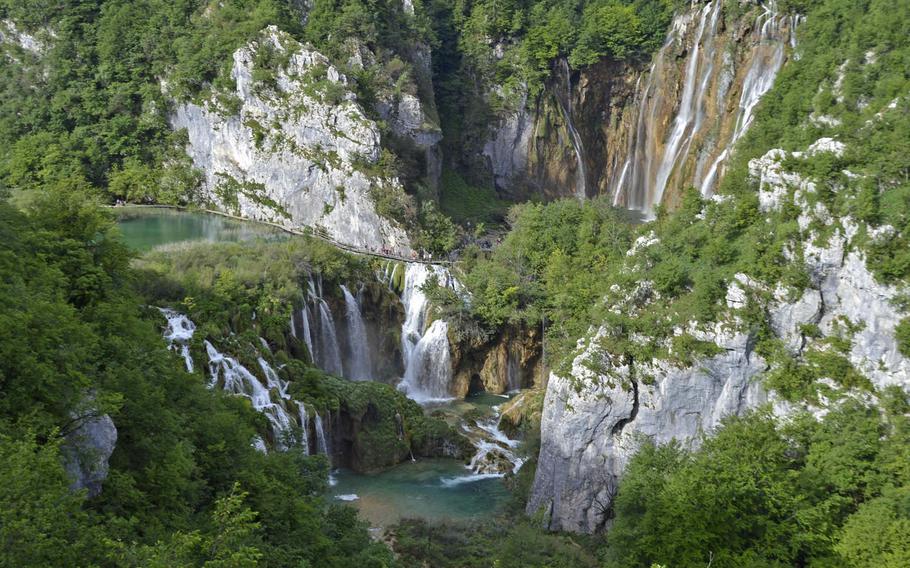
An upper lake surrounded by waterfalls is seen in Plitvice Lakes National Park in Croatia. The mountainous park, which is about 200 miles north of Aviano Air Base in Italy, offers visitors eight different routes to tour the lake system. (Norman Llamas/Stars and Stripes)
Since we arrived in Italy and heard about Plitvice Lakes National Park in Croatia, my family and I have been planning to visit there.
Finally, we did it. Located around 200 miles east of Aviano Air Base, the park, commonly referred to as the “Land of the Falling Lakes,” is the oldest and largest national park in Croatia. As soon as you enter, you are struck by how green and mountainous it is.
There are numerous activities available for visitors, including lake tour programs, mountain climbing, skiing, sledding and biking, but the majority of visitors go to Plitvice to tour the lakes and waterfalls.
The lake system was formed over thousands of years by water flowing over limestone and chalk, depositing travertine barriers that created natural dams. Sixteen named lakes and several smaller, unnamed ones cascade onto each other. Plitvice was added to the UNESCO list of World Heritage sites in 1979.
The first 12 lakes, called the upper lakes, were formed from impermeable dolomite rock. The larger lakes in the system, they have more indented and gentler shores than the other four, called the lower lakes.
The lower lakes were formed from permeable limestone substrate, and cut into a deep canyon with steep cliffs.
The lakes end in an impressive display of waterfalls, at the base of which the Korana River has its source.
A range of climates and different altitudes in the park allow a variety of plants to thrive there, from beech, spruce and fir trees to a mixture of Alpine and Mediterranean vegetation. The area is also home to a variety of animal and bird species including the European brown bear, wolf, eagle, owl, lynx, wildcat and a large woodland grouse called the capercaillie.
You can choose from eight routes around the lakes, labeled by letter and color-coded, based on which entrance the path passes. A complete circuit through the park can be done on trail K, which can be accessed through either the park’s north or south entrance. A little more than 11 miles long, trail K takes about six to eight hours to complete.
My family and I decided to take trail C, which takes four to six hours. The path, which was very well maintained, consisted of wooden planks, gravel, rocks and, in some areas, steps. Parts of the trail were wheelchair accessible but there are sections with steps and steep inclines. The park notes on its website that “trails through the lake zone are not fully adapted for the disabled.”
The views were spectacular. Some trails have boat or bus transfers — fee included in the price of the park entrance ticket — to save you time walking. Make sure you hold onto your entrance ticket because they stamp it at the boat interchanges.
The trails and bridges are narrow, sometimes technical, and when pedestrian traffic is heavy, such as around midday when the park becomes more crowded, it can make you a little nervous. I found myself clutching my son’s hand very tightly on parts of the trail.
Also important to note: Swimming isn’t allowed anywhere in the park. Cycling is allowed only in designated areas.
In grassland parts of the park, there are rest areas with bathrooms and places to grab a bite to eat and something to drink.
If you choose to spend several days in Plitvice, the park has three hotels clustered near entrance two, the south entrance; the Camp Korana campsite, with bungalows and space for up to 500 camping units, about four
miles from entrance one, also called the north entrance; and another campsite, Camp Borje, about nine miles away from entrance two. There are numerous options for private accommodation outside the park.
If you go, make sure to bring passports, which you will need to enter Croatia. It’s a good idea to change some dollars or euros into Croatian kuna before you get to Croatia, too. While most Croatian establishments accept credit cards, they might not accept euros if you’re paying in cash.
If possible, buy tickets prior to arriving at the park to avoid disappointment if they are sold out at the entrances. When you buy tickets, you’ll be asked to choose the date and time of your visit, and whether you want to go in through the north or south entrance. It’s advisable to choose an early-morning entry to avoid the throngs of visitors and tour groups that seem to arrive around midday.
But no matter when you choose to visit, you will more than likely leave amazed and looking forward to going back. At least, that’s how we felt.
DIRECTIONS: Address: Josipa Jovica 19, 53231, Plitvice Lakes, Croatia
TIMES: 7 a.m.- 8 p.m. daily
COSTS: From June 1 to September 30, one adult can expect to pay up to 250 Croatian Kuna (about 36 euros) per day. Children 7-18 are about half the price of an adult ticket, and there are discounts for students and kids under 7. Disabled people enter for free. There’s also a discounted two-day ticket option, and, if you’re staying at one of the hotels near the park, the reception desk can extend one-day tickets.
FOOD: Full restaurants are available at the entrances and exits to the park. Food options at restaurants in the middle of the park range from quick snacks to ice cream to sit-down restaurants where you can order grilled chicken, ribs, steaks, cheeseburgers and sausages.
INFORMATION: Phones: +385 (0) 53 751 014; +385 (0) 53 751 015; e-mail: info@np-plitvicka-jezera.hr. Online: np-plitvicka-jezera.hr/en